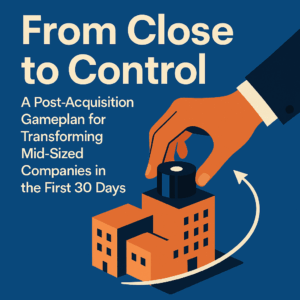From Close to Control
A Post-Acquisition Gameplan for Transforming Mid-Sized Companies in the First 30 Days

Midsized companies, those with revenue between about $10 and $110 million, present a unique challenge for any new leader. Unlike smaller companies, which require simplicity and focus, or large enterprises that benefit from specialist depth and infrastructure, mid-sized businesses exist in a gray zone. Complexity has outpaced structure, but resources are still limited. Leaders must combine the strategic discipline of a large company with the scrappiness of a startup.
There might be no greater challenge than to be a newly placed CEO of a mid-sized portfolio company. Expectations are high: drive growth, professionalize the business, build scalable systems—and do it all while tightly managing costs. These leaders must serve as both architect and builder, strategist and operator. They often inherit teams they didn’t choose, must make critical decisions rapidly with limited data, and are given very little room for error. Success hinges on aligning people, priorities, and processes – quickly and under a the investors’ microscope.
To add complexity, the KPIs at this stage often contradict each other. Leaders must pursue top-line growth and operational scale while simultaneously improving profitability. I’ve yet to find a single playbook that works for every situation.
This role demands high cross-functionality, problem-solving depth, and the ability to motivate and upskill a team through real-time execution. Leaders must be scrappy and hands-on—able to both develop the right strategy, the know-how to implement change and consistency to deliver ongoing results. Hiring for this role is a challenge. For the right leader, this is the most exciting phase of business. Yet for the wrong fit, the cracks won’t show up immediately.
The first 30 days leading a mid-size company is very different than those in almost any other. In a PE-backed acquisition expectations are even higher, time is shorter and the scoreboard is already running. This is not the only way to do it, but here’s how I try to create value fast—and build a foundation for long-term performance in the first 30 days:
- Nail Unit Economics – Before investing in growth, understand how the business actually makes money. Start with unit economics—from raw materials to distribution—to clarify where margin is made (or lost) by product and channel.
- Start Leadership Routines – Consistent leadership rhythms create alignment fast. Daily standups address blockers, weekly reviews track KPIs, and monthly/quarterly meetings connect execution to strategy. These routines shift culture from reactive to proactive.
- Establish Operational Dashboards – Dashboards clarify priorities and drive performance. I focus daily on quality, customer satisfaction, CAC vs. LTV. Weekly on liquidity, COGS, margin by product/channel. Monthly focus on KPIs including working capital, EBITDA margin, inventory CAPx investments and return on capital.
- DOGE the business – Early, decisive cuts show a commitment to efficiency, eliminate waste, and create space for stronger leadership. Cut deep, cut early—it’s easier to add back than to recover from inertia.
- Identify the A-Team – The next stage of growth often needs new types of leaders. Sometimes the #2 is better suited than the current lead. Build a high-performing team through internal promotions and strategic hires (sometimes as fractional executives, such as a Fractional CMO or Fractional COO)
- Make Marketing Earn Its Budget – Marketing spend must tie to contribution margin, retention, or velocity. Too often, I walk into organizations with bloated tech stacks, wasteful agency contracts, and no clear ROI. Effective marketing means continual testing, message refinement, content optimization, and channel discipline. Technology helps—but only when driven by the right people (see #5).
And What I Don’t Do (Yet): Realign the Org Chart
Restructuring too early can create chaos. Until I understand who belongs in what seat—and what structure supports the business’s next phase—any reorg is just moving deck chairs. The right structure becomes clear once routines are in place, KPIs are being tracked, and leadership performance has been observed under pressure.
This is how transformational performance begins—by aligning people, data, and capital around value creation from the very start.
Let’s Talk
I help fast-growing businesses create systems that make bold ideas executable—without chaos.
✔️ Fractional COO and CMO support
✔️ Leadership routines that drive performance
✔️ Cross-functional alignment and accountability
Learn More: http://marc-drucker.com
Connect on LinkedIn: linkedin.com/in/marc-drucker
Schedule Time to Connect: https://bit.ly/MarcDrucker-Calendly